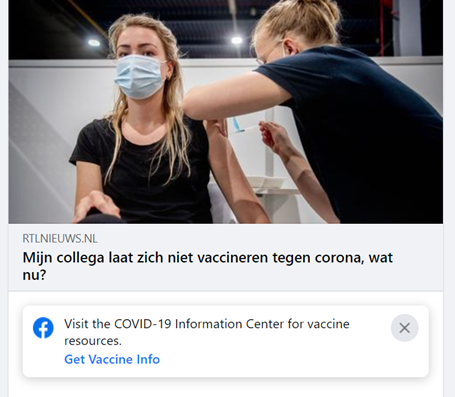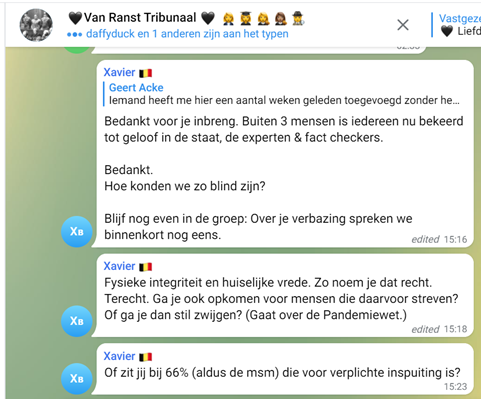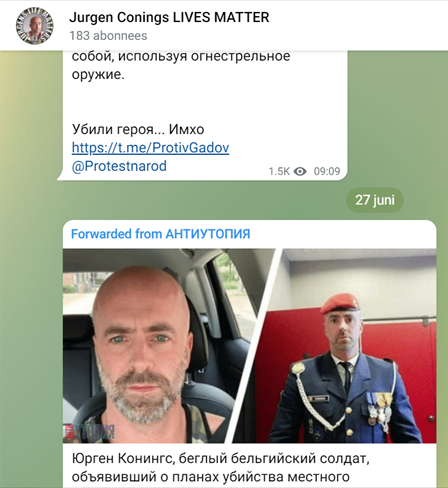
The post-digital infrapolitics of Jurgen Conings
The disappearance and death of Belgian corporal Jurgen Conings in May 2021 is surrounded by mystery. After leaving a farewell note behind, he left into the woods never to return again, along with heavy weapons he took from the barracks. While his family thinks Conings has been murdered and that it is way too much of a coincidence that the mayor of Maaseik found him, authorities claim Conings took his own life. The former corporal is said to have cherished right-extremist ideas and expressed hatred towards well known Flemish virologist Mark van Ranst. According to the police, he threatened to attack van Ranst. The ‘fall from grace’ of corporal Jurgen Conings from the Belgian army illustrates how resorting to infrapolitics, the discourse behind the back of power (Scott, 1990), is necessary when your ideas are not hegemonic.
In the following article the idea of Scott’s infrapolitics (1990) will be updated to fit events of our current post-digital society. The case which will be examined in this paper is that of Jurgen Conings and especially the support groups surrounding this case. It will be argued that in our post 9/11, post-Christchurch era, content moderation has become a panoptical surveillant method. It will become clear that terror-panic (Patel, 2012) content moderation on major social platform sites requires digital infrapolitics. First the context of the case will be discussed briefly. Then the infrapolitics of Jurgen Conings' support groups will be analysed. These groups formed first on Facebook and later also on Telegram as a reaction to what they saw as the demonization of an innocent man. Finally the conclusion will be made that infrapolitics is as relevant as when Scott coined the term, if not more.
Context: Infrapolitics in a post-digital world after Christchurch
A lot has changed since Scott (1990) did his research on infrapolitics of subordinate groups. The contexts which helps explain the enormous hunt for Conings are the post-digital environment we live in and the uprisings of extreme-right terrorism in Christchurch, in 2015. The post-digital society implies that digital media has become part of our social structure and of our everyday lives without being noticed as being ‘digital’ anymore (Blommaert, 2019). We now ‘live in an online-offline nexus in which both zones can no longer be separated’ (Blommaert, 2019: 1). The Jurgen Conings support groups on social media discuss things that are also relevant in the physical world. For understanding Jurgen Conings’ support groups, their post-digital nature must be taken into account. In other words, these groups do not exist in a digital vacuum.
Although platforms such as Facebook are private firms, their platform moderation is in line with law enforcement.
Another recent change that needs attention is the increased attention to far-right extremism after the 2019 massacres in Christchurch New Zealand. For example the removal of the popular pro-Conings group ‘Als 1 Achter Jurgen’ on Facebook did not happen by accident:
‘In the aftermath of the march 2019 massacre at two mosques, governments proposed and adopted new legislation imposing penalties on online platforms that fail to remove unlawful content.’ (Bloch-Wehba, 2021: 117)
Events like this have caused ‘platforms to take aggressive private action against certain forms of speech that are in alignment with government’s own priorities’ (Bloch-Wehba, 2021: 116). This leads to more intensified social media surveillance. Although platforms such as Facebook are private firms, their platform moderation is in line with law enforcement. Social media surveillance happens when publicly available posts are searched by governments with a search vector (Bloch-Wehba, 2021). In a period in which society has to deal with both a pandemic and far-right extremism, rules for what is allowed on social media have been tightened. According to Bloch-Wehba (2021), there is a close relationship between platforms and the police.

Facebook gives warnings for what is 'right' vaccine information; a form of pandemic content moderation.
The 'hard surveillance’ (Patel, 2012) of police and content moderation exist next to ‘soft surveillance’ (Patel, 2012) of other users. The ‘enhanced gaze of the public’ has become the ‘enhanced gaze of the users’, who report ‘wrong’ user generated content. It is the networked character of social media that makes it compelling as a technology of surveillance (Bloch-Wehba, 2021). Although social media gives much opportunities to express alternative views, these same technical affordances censor these views. Whereas after 9/11 a ‘suspicion of brown bodies’ (Patel, 2012) was the case, now the surveillant algorithms of social media also target ‘white bodies’.
These contextual changes combined with biopolitical pandemic management (Agamben, 2021) makes Jurgen Conings and his supporters particularly suspicious. ‘Notions of fear, panic and bias go on to determine who is labelled as deviant or unwanted’ (Patel, 2012: 216) or, in the case of Conings, simply very dangerous. Conings not only expressed far-right ideas online; he also formed a bio-political threat, speaking up against the meticulous and invasive Covid measures prescribed by virologists such as Marc Van Ranst. Although bio-political fear is related to this case, it is beyond the scope of this article to dive into this.
Online moderation is more than a tool to fight against crime and misinformation. It is ‘a means by which spaces are sanitized, purified of perceived troublesome others’ (Patel, 2012: 217). The example of Facebook removing the mourning advert posted by Conings' partner, illustrates how in many cases ‘decisions of platforms go even above and beyond what the law appears to require’ (Bloch-Wehba, 2021: 113). The blunt approaches of platforms to remove possible terrorist content after Christchurch also risk over-censorship (Bloch-Wehba, 2021). A reason this could have happened may be that although the big tech giant ‘has a liability shield, government agencies often engage in efforts to coerce, compel or convince intermediaries to take down ‘harmful content’ or to provide information about the user who posted it, transforming online intermediaries into engines of unaccountable censorship.’ (Bloch-Wehba, 2021: 109)
The Infrapolitics of Jurgen Conings and his supporters
The fact that extreme right and anti-Covid regulation ideas are being tracked and banned from major social media platforms does not mean that they cease to exist. They are non-hegemonic and thus in need of infrapolitics. The notion of hegemony needs some further explanation. Hegemony, a term intensively discussed by Italian politician and Marxist philosopher Antonio Gramsci, refers to certain ideas, ideologies and discourses being dominant over others (Diggit, n.d.). Because hegemonic ideas are typically considered ‘neutral’ or ‘normal’ (Diggit, n.d.), non-hegemonic ideas are considered deviant. The support for virologists is hegemonic and in line with the enlightened trust in science, whereas Conings’ hatred for virologist Van Ranst is ‘deviant’.
Coning’s ideas are not hegemonic, thus subordinate and vulnerable for negative consequences like banning and profile suspension.
The research done by Scott (1990) around economically dependant subordinate groups could explain the contradiction seen in anonymous or private groups and public social media groups. The starting point is that Conings' ideas are not hegemonic, thus subordinate and vulnerable for negative consequences like banning and profile suspension. Whereas on Facebook ‘subordinates’ are ‘denied the luxury of negative reciprocity’ (Scott, 1990), the technological affordances of cloud-based chat apps do make response to power possible. The secure messaging app Signal for example ‘does not collect meta-data; the kind of to-and-from information that accompanies a text message or phone call’ (Bloch-Wehba, 2021: 127).
The FBI director cited by Bloch-Wehba (2021) spoke about ‘the threat of important sources of intelligence and evidence ‘going dark’, so the ‘bad guys’ could communicate without being intercepted by law enforcement' (129). In this quote the gap between the hidden and the public transcript becomes clear. Whereas the public transcript is the open interaction between ‘subordinates’ and those who dominate, the hidden transcript is the critique of power spoken behind the back of the dominant (Scott, 1990). There is a sense of pressure behind a hidden transcript in the examples given by Scott (1990: 9) which closely resemble the words of Conings in his farewell note: ‘I don’t want to and cannot continue with the way the future looks now.’
What we see here is the variety of political discourses in hidden transcripts that is most extreme, as described by Scott (18), namely the ‘explosive rupture of the political cordon sanitaire between the hidden and the public transcript, making the hidden public’. Conings did this by leaving the letter behind in which he threatened virologists and the Belgian regime right before disappearing. He had reached a point where the consequences did not matter anymore. ‘When the subordinate ‘breaks’, they speak for all, making them into something of a local hero.’ (Scott, 1990: 6)
Whereas Facebook groups can be considered to be in the public transcript because user data is used and analysed by Facebook and requested by governments (Bloch-Wehba, 2021), Telegram makes it possible for people to hide their true identities from the governments while sharing all kinds of dissatisfactions about the ones in power. Nevertheless it is in the public domain where the power relations between citizens and the powerful are most manifest (Scott, 1990). One does not come across censored messages and ‘information warnings’ on apps such as Telegram or Signal.
Groups like 'Van Ranst Tribunaal' on Telegram for example work as a hidden transcript because of anonymity. Garton-Ash (2016: 314) argues anonymity ‘is among the most double – edged affordances of the internet. It has contributed to some of the largest online evils while it can support privacy and enable self - expression’. ‘All of us present outward images of ourselves that are often different from what we feel inside.’ (Garton-Ash, 2016: 316)
This characteristic of anonymity is exactly what the goal of infrapolitics is: to successfully pretend in the eye of power (Scott, 1990). This way anonymity becomes a ‘weapon of the weak’ (Scott, 1985), as anonymity changes the power imbalance between citizens and governments. With anonymity, citizens can ‘take back’ some of the power from governments and big-tech companies.
These anonymous groups create a distinct culture, different from what is seen in the public transcript. Hidden transcripts do not only contain speech acts, but a ’whole range of practices that contravene the public transcript’ (Scott, 1990: 15). An example are the support marches organized by Conings’ supporters. What is striking in these groups is the way people form a group by refuting hegemonic ideas and backing each other in contradicting those ideas. In the example below, a group member wonders if the person who expressed the ‘hegemonic’ idea is part of the 66 percent who is for obliged vaccination.

Somebody expressed 'hegemonic ideas' in Van Ranst Tribunaal, a pro - Conings, anti - vaxx group and got many responses.
‘In those groups a specific culture is being created', says Ico Maly. ‘The us-against-them story is fuelled, freedom warriors are celebrated and weaponry is encouraged’. This culture is the infrapolitical culture of extreme right and anti-vax groups that surround the life and death of Jurgen Conings. The freedom and anonymous potential of expression also attracts a lot of interest from Russia, where – as became the more apparent in the Navalny case – free speech is not evident. A quick look on these groups confirms this. Most messages in ‘Jurgen Conings Lives Matter’ are in Russian.

Russian comments in a group about a Flemish 'freedom warrior'.
Conclusion
Infrapolitics remain very important to analyse power and surveillance. The often harsh and government-influenced content moderation on social media along with new affordances of anonymous communication have made infrapolitics more relevant than ever. The case of Jurgen Conings has shown that there is more need to hide because of digital media surveillance, while at the same time there are increasingly more options for new groups to emerge anonymously. Anonymity is the reason these groups can exist. Hidden transcripts on open, easily accessible platforms is resistance in plain sight, characterizing the show-and-share ideology of social media. The content moderation must be placed in a context of high awareness of terrorism after the Christchurch attacks and a society in which social media is part of everyday life. This gives social media platforms unequally much power.
At the meantime people with non-hegemonic ideas resort to hidden transcripts where a distinct culture emerges. Facebook becomes only the surface of the social media ecology where power is most visible. By breaking the cordon sanitaire between the hidden and the public transcript, Jurgen Conings became the hero of extreme-right and anti-vaxing supporters. New infrapolitical groups pop up on different platforms where the ideas of Conings will remain alive after his death and despite digital censorship.
References
Agamben, G. (2021). Epidemie Als Politiek: De Uitzonderingstoestand Als Het Nieuwe Normaal. Amersfoort: Starfish Books.
Bloch-Wehba, H. (2021). Content Moderation As Surveillance. Berkeley Technology Law Journal Vol. 36 pp. 102 – 143.
Blommaert, J. (2019). Political Discourse in Post – Digital Societies. Tilburg Papers in Culture Studies 236. Tilburg University.
Diggit Magazine (n.d.) ‘Hegemony’. Diggit Magazine Wiki. Retrieved here.
Garton – Ash, T. (2016) Free Speech: Ten Principles For a Connected World. London: Atlantic Books.
Patel, T. (2012). Surveillance, Suspicion and Stigma: Brown Bodies in a Terror – Panic Climate. Surveillance & Society. Vol 10 (3/4) pp. 215 – 234.
Scott, J. (1985). Weapons of the Weak: Everyday Forms of Peasant Resistance. New Haven & London: Yale University Press.
Scott, J. (1990). Domination & The Arts of Resistance. New Haven & London: Yale University Press.